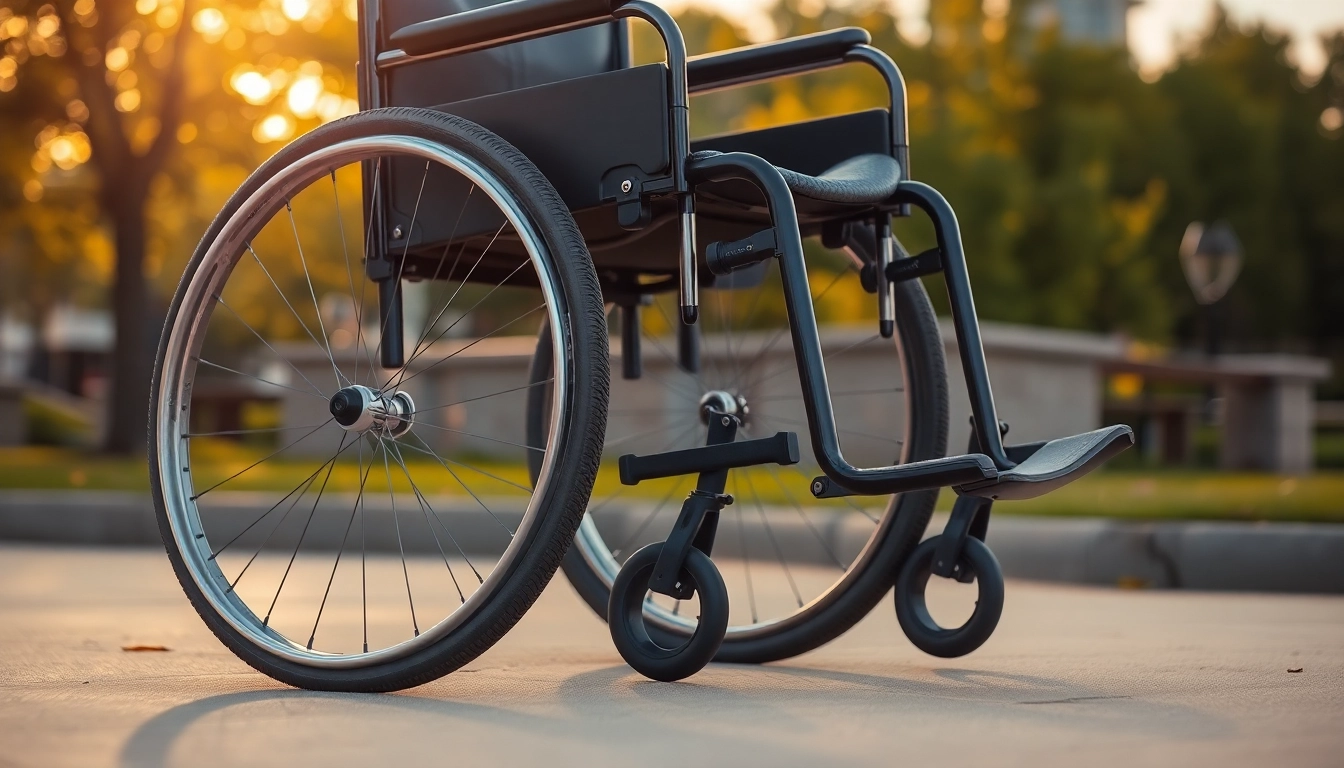Understanding Manual Wheelchairs
Manual wheelchairs are essential mobility aids for individuals with limited mobility, providing independence and flexibility. Unlike powered wheelchairs, manual wheelchairs rely on human power for propulsion, making them a lightweight and often more economical option. This article will explore various aspects of manual wheelchairs, including their features, types, maintenance tips, accessories, and available resources. If you are in search of a manual wheelchair, understanding these factors can help you make an informed choice.
What is a Manual Wheelchair?
A manual wheelchair is a wheelchair that is propelled by the user’s physical effort or by an assistant. These wheelchairs come in various designs and sizes, and they can fit a wide range of user requirements. Typically equipped with two large rear wheels and one or two small front wheels, manual wheelchairs are designed for ease of maneuverability. They allow users to navigate through different terrains, whether indoors or outdoors, by employing techniques such as pushing on the large wheel rims.
Key Features to Consider
When selecting a manual wheelchair, it’s crucial to consider various features that can impact the user’s experience. Key features include:
- Weight: Lighter wheelchairs are generally easier to transport and maneuver.
- Frame Type: Fixed, folding, or collapsible frames offer different levels of portability and stability.
- Wheel Size: Larger wheels offer better performance on rough terrains, whereas smaller wheels are conducive for indoor use.
- Seat Width and Depth: A proper fit ensures comfort and aids in efficient mobility.
- Footrests and Armrests: Adjustable or removable options increase comfort and adaptability.
- Customization Options: Accessories that can be added or modified to meet specific needs, such as reclining backs.
Benefits of Using Manual Wheelchairs
Manual wheelchairs offer numerous advantages, making them a popular choice for many users:
- Independence: Users can control their mobility and navigate spaces with ease, promoting greater independence.
- Cost-Effective: Typically less expensive than powered options, manual wheelchairs can be more accessible.
- Exercise: Propelling a manual wheelchair can encourage upper body strength and conditioning for the user.
- Compact Size: Manual wheelchairs are usually lighter and more compact, making them easier to transport.
- Accessibility: Many environments are designed to accommodate manual wheelchairs, providing easier access in differing settings.
Selecting the Ideal Manual Wheelchair
Assessing User Needs and Lifestyle
Selecting the right manual wheelchair involves a thorough assessment of the user’s needs and lifestyle. Critical factors to consider include:
- Physical Abilities: Assess the user’s physical capabilities, including strength and endurance for propelling the chair.
- Daily Activities: Consider the typical activities the user engages in, such as work, leisure, and outdoor excursions.
- Environment: Understand the environments where the wheelchair will be predominantly used, including home, work, and public spaces.
- Transport Needs: Evaluate how the wheelchair will be transported when traveling in vehicles or public transport.
Types of Manual Wheelchairs Available
Manual wheelchairs come in many varieties, each designed to cater to specific user needs:
- Standard Manual Wheelchairs: Basic models suitable for short-term use or occasional travel.
- Lightweight Wheelchairs: Made for easy transport and maneuverability, ideal for those with upper body strength.
- Heavy-Duty Wheelchairs: Designed to accommodate larger users with reinforced frames and wider seats.
- Sport Wheelchairs: Specifically designed for sports activities like basketball or tennis, featuring unique frame designs for performance.
- Transport Wheelchairs: Lightweight and often have smaller wheels, making them optimal for being pushed by a caregiver.
Customizing Your Manual Wheelchair
Customization plays a key role in ensuring that a manual wheelchair meets the specific needs of each user. Options include:
- Adjustable Seating: Custom seat cushions, backrests, and armrests cater to ergonomic preferences.
- Wheel Options: Selecting different styles of tires (e.g., solid vs. pneumatic) to handle various terrains.
- Accessories: Attachments such as cup holders, storage bags, and footrests enhance comfort and functionality.
- Color Customization: Aesthetic personalization options that allow users to express their personality.
Maintenance Tips for Manual Wheelchairs
Regular Inspection and Care
To ensure optimal performance and longevity, regular maintenance of a manual wheelchair is essential. Recommended practices include:
- Inspect Tires: Check for proper inflation, wear, or damage and replace or repair as needed.
- Wheel Alignment: Ensure that the wheels are aligned correctly to avoid unnecessary strain while propelling.
- Frame Checks: Look for any signs of wear, looseness, or corrosion in the frame and fix promptly.
- Cleaning: Regularly clean the wheels, fabric, and frame to prevent grime buildup and enhance longevity.
Common Repairs and Troubleshooting
Being proactive about potential issues can help avoid more significant problems. Common repairs and troubleshooting strategies include:
- Punctured Tires: Learn how to patch or replace tires should they become punctured.
- Loose Wheels: Adjust and tighten wheel nuts to ensure stability and safety.
- Binding Mechanisms: For folding wheelchairs, check and lubricate folding mechanisms to ensure easy operation.
- Suspension Issues: Contact a professional for problems with suspension systems if present.
Extending the Life of Your Manual Wheelchair
To maximize the lifespan of a manual wheelchair, users can take several proactive measures:
- Proper Use: Adhere to weight limits and avoid using the wheelchair on unsuitable terrains.
- Coverings: Use protective covers when storing outdoors or during transport to prevent weather damage.
- Regular Professional Maintenance: Seek professional servicing to address any underlying issues before they escalate.
- Avoiding Overloading: Carry only the recommended weight to prevent undue strain on the wheelchair structure.
Manual Wheelchair Accessories
Essential Accessories for Comfort and Safety
Adding accessories can significantly enhance the comfort and safety of manual wheelchair users. Some essential accessories include:
- Cushioned Seat Covers: Provide additional comfort and reduce pressure sores.
- Armrest Pads: Soft padding can help alleviate pressure and increase comfort during extended use.
- Lap Belts: Safety straps can prevent the user from slipping out of the chair.
- Anti-Tippers: Devices installed on the back of the wheelchair to prevent it from tipping over.
Technology Upgrades for Enhanced Usability
Modern advancements have allowed for various technology upgrades that can enhance the user experience, including:
- Smart Sensors: Devices that can detect obstacles and offer alerts to enhance user safety.
- Electric Assist Wheels: Manual wheelchairs can be transformed with add-on electric wheel systems for extra propulsion.
- GPS Navigation Devices: Help users navigate through unfamiliar areas safely.
- Mobile Apps: Applications designed to help users locate accessible venues or plot routes that are user-friendly.
Storage Options and Carrying Solutions
Effective storage solutions facilitate easier transport and convenience in daily activities. Consider the following:
- Backpacks: Specially designed backpacks that attach securely to the wheelchair.
- Panniers: Side bags that can hold personal items without affecting balance.
- Storage Cushions: Cushions that double as storage for items while providing seating support.
- Utility Trays: Trays that can be mounted for easy access to food, drinks, or other essential items.
Resources and Support for Manual Wheelchair Users
Finding Community and Online Support
Connecting with communities and support groups can provide valuable resources for manual wheelchair users. Online forums, social media groups, and local community organizations can foster relationships and provide assistance with adapting to new mobility challenges.
Government Resources and Assistance Programs
Many governments offer assistance programs for individuals using manual wheelchairs, including financial aid, grants, or resource networks. It’s recommended to check local health departments or disability services for more information on available programs.
Connecting with Local Mobility Specialists
Reaching out to local mobility specialists can be invaluable for personalized advice, assessment, and maintenance services. They can assist in finding the right equipment, necessary upgrades, and ongoing support for wheelchair users.



